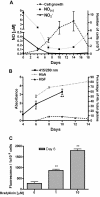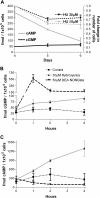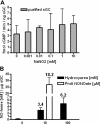Hydroxyurea nitrosylates and activates soluble guanylyl cyclase in human erythroid cells
- PMID: 17993617
- PMCID: PMC2214757
- DOI: 10.1182/blood-2007-05-088732
Hydroxyurea nitrosylates and activates soluble guanylyl cyclase in human erythroid cells
Abstract
Hydroxyurea, a drug widely used for treating myeloproliferative diseases, has also been approved for the treatment of sickle cell disease by raising fetal hemoglobin (HbF). We have shown that nitric oxide (NO) and the soluble guanylyl cyclase (sGC) pathways are involved in hydroxyurea induction of HbF levels in erythroid progenitor cells (EPCs). We demonstrate now that during erythroid differentiation, endothelial NO synthase mRNA and protein levels decline steadily, as does the production of NO derivatives and cyclic adenosine monophosphate (cAMP) levels, but guanosine 3',5'-cyclic monophosphate (cGMP) levels are stable. Hydroxyurea increased intracellular cGMP levels and cAMP levels in EPCs. The NO donor, DEANONOate, induced much higher cGMP levels, but reduced cAMP levels. Hydroxyurea (1 mM) induced production of approximately 45 pM cGMP/minute/ng of purified sGC, similar to induction by 1 muM DEANONOate. We found that hydroxyurea and ProliNONOate produced iron-nitrosyl derivatives of sGC. Thus, we confirm that hydroxyurea can directly interact with the deoxy-heme of sGC, presumably by a free-radical nitroxide pathway, and activate cGMP production. These data add to an expanding appreciation of the role of hydroxyurea as an inducer of the NO/cGMP pathway in EPCs. These mechanisms may also be involved in the cytostatic effects of hydroxyurea, as well as the induction of HbF.
Figures





Similar articles
-
Hydroxyurea generates nitric oxide in human erythroid cells: mechanisms for gamma-globin gene activation.Exp Biol Med (Maywood). 2009 Nov;234(11):1374-82. doi: 10.3181/0811-RM-339. Epub 2009 Aug 5. Exp Biol Med (Maywood). 2009. PMID: 19657070 Free PMC article.
-
Regulation of Sertoli cell tight junction dynamics in the rat testis via the nitric oxide synthase/soluble guanylate cyclase/3',5'-cyclic guanosine monophosphate/protein kinase G signaling pathway: an in vitro study.Endocrinology. 2003 Jul;144(7):3114-29. doi: 10.1210/en.2002-0167. Endocrinology. 2003. PMID: 12810568
-
Notch activation augments nitric oxide/soluble guanylyl cyclase signaling in immortalized ovarian surface epithelial cells and ovarian cancer cells.Cell Signal. 2013 Dec;25(12):2780-7. doi: 10.1016/j.cellsig.2013.09.008. Epub 2013 Sep 13. Cell Signal. 2013. PMID: 24041655
-
Role of the nitric oxide-soluble guanylyl cyclase pathway in obstructive airway diseases.Pulm Pharmacol Ther. 2014 Oct;29(1):1-6. doi: 10.1016/j.pupt.2014.07.004. Epub 2014 Jul 17. Pulm Pharmacol Ther. 2014. PMID: 25043200 Review.
-
Structure and regulation of soluble guanylate cyclase.Annu Rev Biochem. 2012;81:533-59. doi: 10.1146/annurev-biochem-050410-100030. Epub 2012 Feb 9. Annu Rev Biochem. 2012. PMID: 22404633 Review.
Cited by
-
Generation of a genomic reporter assay system for analysis of γ- and β-globin gene regulation.FASEB J. 2012 Apr;26(4):1736-44. doi: 10.1096/fj.11-199356. Epub 2012 Jan 20. FASEB J. 2012. PMID: 22267339 Free PMC article.
-
Hydroxyurea generates nitric oxide in human erythroid cells: mechanisms for gamma-globin gene activation.Exp Biol Med (Maywood). 2009 Nov;234(11):1374-82. doi: 10.3181/0811-RM-339. Epub 2009 Aug 5. Exp Biol Med (Maywood). 2009. PMID: 19657070 Free PMC article.
-
Sustained enhancement of OCTN1 transporter expression in association with hydroxyurea induced γ-globin expression in erythroid progenitors.Exp Hematol. 2017 Jan;45:69-73.e2. doi: 10.1016/j.exphem.2016.09.001. Epub 2016 Sep 8. Exp Hematol. 2017. PMID: 27616638 Free PMC article.
-
Globin gene expression in correlation with G protein-related genes during erythroid differentiation.BMC Genomics. 2013 Feb 20;14:116. doi: 10.1186/1471-2164-14-116. BMC Genomics. 2013. PMID: 23425329 Free PMC article.
-
Role of hydroxycarbamide in prevention of complications in patients with sickle cell disease.Ther Clin Risk Manag. 2009;5:745-55. doi: 10.2147/tcrm.s4769. Epub 2009 Sep 24. Ther Clin Risk Manag. 2009. PMID: 19816573 Free PMC article.
References
-
- Charache S, Terrin ML, Moore RD, et al. Effect of hydroxyurea on the frequency of painful crises in sickle cell anemia: investigators of the Multicenter Study of Hydroxyurea in Sickle Cell Anemia. N Engl J Med. 1995;332:1317–1322. - PubMed
-
- Atweh GF, Schechter AN. Pharmacologic induction of fetal hemoglobin: raising the therapeutic bar in sickle cell disease. Curr Opin Hematol. 2001;8:123–130. - PubMed
-
- Nahavandi M, Tavakkoli F, Wyche MQ, Perlin E, Winter WP, Castro O. Nitric oxide and cyclic GMP levels in sickle cell patients receiving hydroxyurea. Br J Haematol. 2002;119:855–857. - PubMed
Publication types
MeSH terms
Substances
Grants and funding
LinkOut - more resources
Full Text Sources
Other Literature Sources

